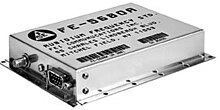Rubidium oscillator
A rubidium oscillator , also known as a rubidium atomic clock , is an oscillator that uses the hyperfine structure constant of an isotope of the chemical element rubidium ( 87 Rb) to derive an accurate time reference. This allows compact and inexpensive atomic clocks to be produced. Rubidium oscillators are used for precise time and frequency references in transmission systems , mobile radio stations , as reference signals in test and inspection devices and as timers in the satellites of the Global Positioning System (GPS).
Rubidium atomic clocks, however, have a higher relative standard deviation than atomic clocks with a cesium fountain . The more voluminous and more expensive atomic clocks with cesium fountain are used as frequency standards for determining the international atomic time (TAI) because of the higher precision.
construction
The rubidium oscillator consists of a gas discharge lamp filled with rubidium , the light of which is passed through a small chamber with gaseous rubidium. The intensity of the light is measured by a photodetector . If the chamber is irradiated with gaseous rubidium by microwaves with a frequency of 6,834,682,610.904324 Hz (approx. 6.8 GHz) - this is the frequency of the hyperfine structure transition of 87 Rb with a relative standard deviation of 3 * 10 −15 - comes Due to resonance effects in the rubidium, there is a reduction in the intensity of the light at the photodetector, which can be measured.
This change in brightness is used as a control signal in a frequency locked loop in order to change an electrically tunable crystal oscillator , which on average is tuned to the frequency of the hyperfine structure transition of approx. 6.8 ... GHz. The electrical oscillation generated by the quartz oscillator serves on the one hand as part of the control loop to be radiated into the resonance chamber with gaseous rubidium via an antenna . On the other hand, this frequency is used to make it available with frequency dividers for further processing. Depending on the application, different values are common, such as 10 MHz or a second pulse .
If there is a small frequency deviation in the quartz oscillator, for example due to interfering temperature influences, this results in an increase in the light intensity on the photodetector. The electronic control system then changes the electrically variable frequency of the crystal oscillator so that it again corresponds to the frequency of 6,834,682,610.904324 Hz of the hyperfine structure transition of 87 Rb and the intensity of the light on the photodetector is kept to a minimum. In order to minimize the deviations of the quartz oscillator due to external influences, it is designed as a heated quartz oscillator (OCXO) from certain accuracy classes.
Rubidium oscillators have a limited service life , which is primarily determined by the gas discharge lamp used and its failure. Typical lifetimes for the lamp are around 10 years.
Web links
Individual evidence
- ↑ QUANTUM Chip Scale Atomic Clock. Microsemi Corporation, accessed January 18, 2017 .
- ↑ Recommended values of standard frequencies for applications including secondary representations of the definition of the second. BIPM, accessed April 22, 2014 .
- ↑ a b PRS10 - Rubidium frequency standard with low phase noise. (No longer available online.) Stanford Research Systems, archived from the original on March 17, 2015 ; Retrieved April 22, 2014 . Info: The archive link was inserted automatically and has not yet been checked. Please check the original and archive link according to the instructions and then remove this notice.

